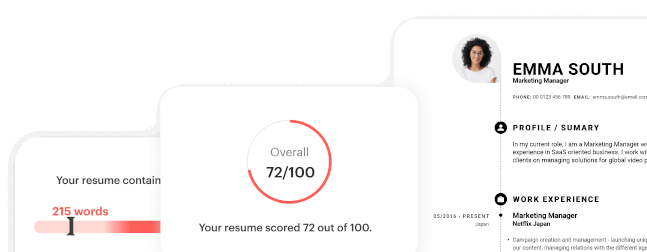If you're after a job in the transportation and logistics field, having a solid resume is the key. With our straightforward tips, clear examples, and practical templates, putting together your transportation and logistics resume just got a whole lot easier.
In this guide, we will teach some essential steps for writing a transportation and logistics resume. Keep reading to learn all about:
- Choosing a resume format that fits your experience level
- Writing a resume summary that helps you stand out
- Including both hard and soft skills to showcase your diverse skillset
- Describing relevant work experience using quantifiable details
- Listing educational credentials accurately on your resume
- Accessing the best job search resources for transportation & logistics professionals
Still looking for a job? These 100+ resources will tell you everything you need to get hired fast.
1. Choose a resume format that fits your experience level
The standard resume format expected by most employers is the reverse-chronological resume.
Reverse-chronological resumes focus primarily on work experience, listing an applicant’s most recent job first and working backward from there. For Transportation and Logistics professionals, this type of resume format provides ample opportunity to showcase hands-on experience and specialized expertise.
However, if you are new to the industry and lack relevant work experience, you may want to consider one of the following alternative formats:
- The Functional Resume: Functional resumes remove the focus from work experience and place it instead on education, training, skills, and unpaid experience. This format is well-suited for current students or trainees, as well as recent graduates.
- The Hybrid Resume: Hybrid resumes combine elements of both the functional and reverse-chronological resumes to spread the focus of the document out between all sections. This format works well for applicants with a mix of both academic and professional experience, applicants who are changing career paths, and applicants who have large gaps in their work histories.
Choose your preferred template and make your resume shine.
2. Write a transportation & logistics resume summary that helps you stand out
A resume summary is a short statement at the beginning of a resume that helps to introduce an applicant to an employer. Good summaries are between one to three sentences in length, focusing on the applicant’s best examples of their skills, experience, or professional achievements.
To help illustrate how to write an effective resume summary as a Transportation and Logistics professional, here is a weak example followed by a correction and explanation:
Incorrect transportation & logistics professional profile example
Transportation Logistics manager with many years of experience working in a corporate warehouse for cosmetics. Exceptionally skilled at efficient distribution of products and achieving high satisfaction levels with coordinating partners.
Why is this Incorrect?
In this example, the applicant is too vague. While they hint at the fact that they are highly experienced and have many key accomplishments, they fail to provide any context that would make this information useful or compelling to employers.
Corrected transportation and logistics resume summary example
Effective Transportation Manager specialized in distributing cosmetic products from a corporate warehouse. More than 5 years of experience coordinating with major corporate clients such as Sephora and Ulta Beauty, achieving a delivery satisfaction rate of 98% and a 75% decrease in delivery errors.
Why is this Correct?
In this example, the applicant improves their summary immensely by providing exact figures such as their years of experience and key percentages to go along with their accomplishments. With this summary, the applicant is far more likely to grab an employer’s attention and keep them interested enough to read through the rest of their resume.
3. Include both hard and soft skills to showcase your diverse transportation & logistics skillset
Any time you write a Transportation and Logistics resume, it is crucial to showcase a wide range of talents. This industry deals with both technical complexities and interpersonal challenges, making it essential for you to include both hard and soft skills on your resume
Hard skills refer to your learned abilities gained through education and training, while soft skills refer to your ability to work well with others and understand the working environment around you.
With this in mind, here are 10 examples of both hard and soft skills to include on a Transportation and Logistics resume:
The best hard skills to put on your transporation & logistics resume
- Delivery tracking
- Coordinating distributions
- Developing business portfolios
- Shipment capacity & coverage
- Bookkeeping & accounting
- Rate negotiation
- Customer billing
- Creating invoices
- Cold calling
- Sales tactics
Effective transportation & logistics soft skills for your CV
- Adaptability
- Attention to detail
- Leadership
- Clear communication
- Collaboration & teamwork
- Creativity
- Problem-solving
- Critical thinking
- Multi-tasking
- Stress & time management
4. Describe relevant work experience using quantifiable details
Your work experience section is where your hands-on expertise can really shine.
When writing a work experience section, it is important to provide in-depth bullet points that are also concise. You can do this by using exact and quantifiable details, such as percent changes in profits or improvements in productivity.
Here is an example of a work experience entry from a transportation & logistics resume
Master Logistics, Austin, TX
Transportation & Logistics Coordinator
June 2019 to May 2021
- Developed and managed a portfolio of business for both shippers and carriers.
- Built long-lasting and reliable relationships with clients, onboarding more than 10 new major clients, increasing profit margins by 15%.
- Tracked all deliveries with precise attention to detail, achieving a delivery error rate of less than 3%.
5. List educational credentials accurately on your resume
Generally, the minimum educational requirement to become a transportation and logistics professional is either an associate’s or a bachelor’s degree in a related field. However, in some cases, an applicant may be able to obtain a logistics role without a degree if they have adequate training and experience.
Regardless of what level of education you have, it is important to list is accurately on your resume. Always be sure to include:
- Your diploma or degree title
- The name of the university, college, or certifying institution
- Your date of graduation
Additionally, you can include any relevant academic accomplishments or certifications to help round out your education section further.
Here is an example of a well-crafted education section on a transportation & logistics resume
Volunteer State Community College, Gallatin, TN
A.S. in Logistics Management
- Graduated: 2021
- President of the Student Government Association
Certifications:
- Logistics, Transportation, and Distribution Certification (CLTD), The Association for Supply Chain Management
6. Include relevant extra sections in your transportation & logistics resume
Including extra sections on your transportation and logistics resume is essential as it allows you to provide a more comprehensive and well-rounded view of your skills, experiences, and qualifications.
These additional sections can showcase your specific expertise, highlight relevant certifications or training, and demonstrate your involvement in industry-related activities.
One specific example of an extra section that can greatly benefit a transportation and logistics resume is the "Professional Associations and Memberships" section.
This section allows you to highlight your active involvement in industry organizations or associations, demonstrating your commitment to staying updated with the latest trends, best practices, and regulations.
Here's an example of how to properly list an extra section on your transportation & logistics resume
Certifications and Training
- Certified Supply Chain Professional (CSCP) - APICS
- Transportation and Logistics Management Certificate - XYZ University
- Hazardous Materials (HAZMAT) Certification - Department of Transportation (DOT)
- Lean Six Sigma Green Belt Certification - XYZ Institute
- International Air Transport Association (IATA) Dangerous Goods Regulations Certification
7. Valuable job search resources for transportation & logistics professionals
If you're setting your sights on job opportunities in the transportation and logistics sector, having the right resources can smoothen your ride.
- Specific job boards: Narrow down your search with industry-focused job boards like JobsInLogistics.com or FleetJobs — they're all about transportation and logistics openings.
- Professional networks: Join professional organizations such as American Society of Transportation & Logistics (ASTL) or International Society of Logistics (SOLE). They offer more than just networking - think educational resources and job boards.
- Online learning platforms: Stand out against the competition by brushing up your skills or learning new ones using online platforms like Coursera and Udemy.
- LinkedIn: It's not just a professional networking site. It's a hub where employers scout for talent. Make sure your profile is up-to-date and polished.
- Stay current: Don't let industry changes pass you by. Regularly read up on the latest trends and technologies in transportation and logistics through trade publications like Transport Topics and Logistics Management.
In the fast-moving world of transportation and logistics, these resources can give you the edge you need in your job hunt and career advancement.
Transportation / Logistics Resume FAQ
Every part of your resume matters, but the key is to highlight your relevant skills, experiences, and achievements in the transportation and logistics field. Tailor your resume to each job application for the best results.
Include only relevant work experience on your resume. If you've got broad experience, focus on the roles that align with the job you're applying for in transportation and logistics.
As a rule of thumb, your resume should ideally span one to two pages. It should be detailed enough to cover your qualifications, but concise enough to keep it interesting.
Be specific about your accomplishments and quantify them when possible. For instance, instead of saying you managed a logistics team, say you led a 5-member team that brought down delivery times by 20%.
Yes, listing relevant certifications can be a great advantage. It shows your commitment to the field and can give you an edge over other candidates. So, if you have any, sure do include them.































![How to Write a Professional Resume Summary? [+Examples]](https://d2xe0iugdha6pz.cloudfront.net/article-small-images/i-Profile.svg)
![How to Put Your Education on a Resume? [+Examples]](https://d2xe0iugdha6pz.cloudfront.net/article-small-images/i-Collage-Universities.svg)
![How to Describe Your Work Experience on a Resume? [+Examples]](https://d2xe0iugdha6pz.cloudfront.net/article-small-images/Experience.svg)


